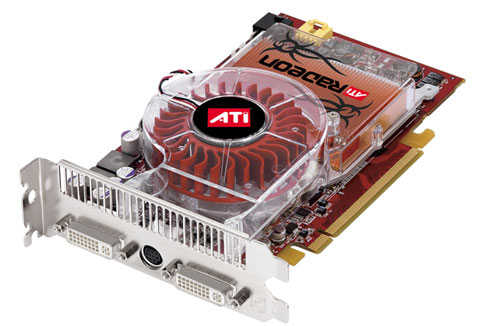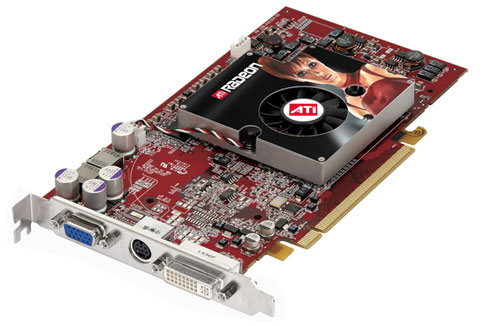ATI's New Radeon X850 and X800 Lines: A Smorgasbord of GPUs
by Anand Lal Shimpi & Derek Wilson on December 1, 2004 9:41 AM EST- Posted in
- GPUs
Some people didn't expect it to happen this season, and it is a little late in the year. But it is still fall, and, still on schedule, ATI's fall refresh part is here. Maintaining the 6 month product cycle has been quite struggle over the past few years, and seems to have stretched into something more like 7 or 8 months. We'll have to wait and see what happens this spring before we can really see if the industry is going to start relaxing the product cycle a little, or if this last round was just a little more intense for both ATI and NVIDIA. Today sees the introduction of a new PCI Express only line up from ATI. Rumor has it that ATI will be finishing up their PCI Express to AGP bridge chip sometime in January, so we may see these and other products make their way across platforms sometime next quarter.
The two new chips that ATI is putting on cards today are the R480 and R430. The R480 is the higher end part in this case. There is absolutely no architectural difference between these new chips and the original R423 on which they are based. That being said, they are both, in fact, different chips than their predecessor. This magical fact is made possible through the wonders of process enhancements.
As a fabrication process matures, it is often possible to find ways to do things better, more efficiently, and with fewer defects in the final silicon. These are the types of process enhancements that go on most of the time at any given fab. Generally, as the process gets better, yield improves, costs go down, and profits go up. In the case of the current generation of graphics cards, it took quite a while to go from launch to high availability. Occasionally, it's also possible to find ways of doing things that enhance the performance of the final product as well. At this point, TSMC has been using their 130nm low-k process to fab ATI's R420 and R423 chips for quite some time now.
Having gotten quite comfortable with the 130nm low-k fab technology, as well as the R423, TSMC and ATI have been able to refine the process for the R480 by enhancing the silicon substrate through component selection and placement to further improve signal integrity leading to higher core clock frequencies. They were also able to shorten trace lengths from the core to memory. Unfortunately, we couldn't get ATI to go into any more detail on exactly what "substrate enhancements" were made, but shorter trace lengths translates to the possibility of higher stable memory clock speeds for ATI cards using the enhanced R480 chip.
The differences between the R423 and the R430 are clearer cut. The R430 is fabbed on the 110nm process rather than the 130nm low-k process. ATI isn't able to push the R430 chips at clock speeds that rival the R480, but this matches well with cooler running, lower clocked 16 and 12 pixel pipe solutions (which is exactly what ATI is offering with R430 based cards).
In addition to the fact that the R480 will be a high performance part, it will also be packed on two slot cards. The stock thermal solution ATI provides is quite different from what we've seen in the past, and quite resembles the leaf-blower type systems we've seen attached to older GeForce FX based products. Aside from the hi-revving but throaty turbo charged 4-cylinder-like whine at boot time, the card calms down and runs quite quietly even under the highest gaming stress. To be completely fair, we haven't tested it in oven-like weather or at a constant high overclock. If the fan has to spin all the way up, you may get the feeling you've got a Civic with an aftermarket exhaust racing around in your box.
Just so you get an idea of what it sounds like, we've provided an mp3 of our X850 XT PE testbed starting up. The sound level of the fan at the end of the MP3 is the loudest it ever got for us during our testing, but once again we were testing in an open air environment and not in a closed (potentially quite warm) case. For a comparison point, here is an mp3 of the same testbed with an X800 XT starting up.

Dual DVI and Dual Slots are the markings of ATI's X850 line
If owning a single slot solution is a deciding factor, the R430 will fulfill that niche. The lower clocked, 110nm solution won't be fitted with the leaf-blower, but a much smaller hsf. ATI has said that it will be possible to passively cool one of these in a BTX system as well. Getting very quiet, very solid performance out of these chips will be a simple matter.

A single slot and no power connector are the telling characteristics of ATI's 0.11-micron X800 line
Product will likely begin shipping early next week, as this is when it will be available for order online. It won't show up on brick and mortar shelves for a few more weeks. Getting product out the door has been a tough thing for ATI and NVIDIA in the past, especially for their highest end parts. As all parties involved have had some practice with this part for a while, we would have been happier if ATI had gotten on the ball and had product on shelves today, if they do ship next week, they won't be in bad shape. We can't say enough about how important it is to make product available as close to a launch as possible. It doesn't matter how well we compare products if it's impossible to get a hold of them. Unfortunately, unless product is available at launch, it makes it very hard for us to guess when we will see anything come along. Our case and point is the X700 XT. It wasn't available at launch, and we may never see it if the cards we look at today make it out the door.
But that's enough about the chips; let's take a look at what we can expect to see in the way of actual products equipped with these new improved GPUs.










69 Comments
View All Comments
kmmatney - Wednesday, December 1, 2004 - link
Man, It's way too confusing buying a card these days. There were already way too many ATI model numbers out there, and now this! Why can't they have an entry, Low Mid-range, High Mid-Range and high-end card and leave it at that.sophus - Wednesday, December 1, 2004 - link
model numbers are out of control. just go look at pricewatch.com and get bombarded by all of the models...i've heard that the purpose of the all the numbers/acronyms is to confuse the consumer into buying a "newer" part, read: more profitable for them.
the prices are getting too high. $500 for a card?! too much money for a (practical) gamer's most frequently upgraded part.
also, the availability for these cards is way too low. How long after the release do we have to wait until we can actually see these in stores? is demand that high and supply that low? is there a leak in their bank accounts? are their manuf processes too high?
a small tweak in their product and they demand top-dollar? or rather, "well this NEW product is just a little bit better then our last one. so instead of lowering the price on our OLD product, we'll just set the bar higher for our NEW product."
Mykal Starclem - Wednesday, December 1, 2004 - link
Quote:I just hope that the large increase in the variety of cards means that a couple of them which actually be available to buy
lol
Kasper4christ - Wednesday, December 1, 2004 - link
*cough* Spell check :PPage 2
"before it's clock soeeds are officially set in stone."
Steve Guilliot - Wednesday, December 1, 2004 - link
#31Software HDTV decoders/encoder require working DxVA (i.e. ATI cards) for best performance, and sometimes to work at all. For people intersted in going the HTPC route, the video processor is very important, just not to you.
miketheidiot - Wednesday, December 1, 2004 - link
extremely unimpressive. My 6800 is still fine.Regs - Wednesday, December 1, 2004 - link
This does not look like a refreash to me. Just seems more like overclocked parts trying to win the performance crown that "no 'one'" can afford. I expect Nvidia to do the same. ATI even has the nerve to charge 400 dollars for a 12 pipe design. At least have it include Dual Dvi. I know it may not need the extra 4 pipes enabled, but it just seems like their taking you for a ride for a few extra MHz.Araemo - Wednesday, December 1, 2004 - link
#24:I stand corrected, though iDCT is VERY old tech, that nVidia had around from at least the geforce 4 series(if not the gf2 series), and ATI has had since sometime in the RAGE series.
And the "Motion compensation" sounds like what ATI has enabled via their drivers in a couple aps (Divx Player and Realplayer, if I'm not mistaken.)
Motion estimation is what I was thinking the only new use was, my mistake. Though I DO hope that nvidia at least has iDCT working, if not the motion compensation as well. The main selling point I saw w/ regards to the video processor was the ENCODE.. since I've never had a cpu usage problem while decoding a video.. even on a pentium 2 running windows 2000.
#26: I don't think 'decent' is the right word.. their drivers are decent, they just aren't fast.
I draw the distinction because of the number of video cards I've had with UNSTABLE drivers. I am very happy with the stability of the Catalyst 4.x series drivers.
That said.. nVidia has stable AND fast openGL drivers.. hello ATI?
ViRGE - Wednesday, December 1, 2004 - link
#4, it's not worth getting worked up over anyone's video processor at this point. Nvidia's 68xx processor may be broken, but even if it worked, it doesn't make a difference. There are not any MPEG4 decoders on the market that can use either company's card, and WMV acceleration on my X800 Pro is having no impact: frame rates and CPU usage stay the same. And let's not even talk about hardware assisted encoding...The whole "video processor" idea has so far turned out to be a joke from both sides.
Zebo - Wednesday, December 1, 2004 - link
#10 the USD has lost 33% of it's value since GF4 days so in reality Vcards are the same price just your dollar is'nt worth anything.